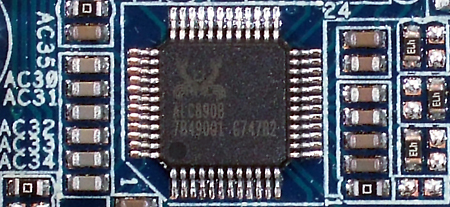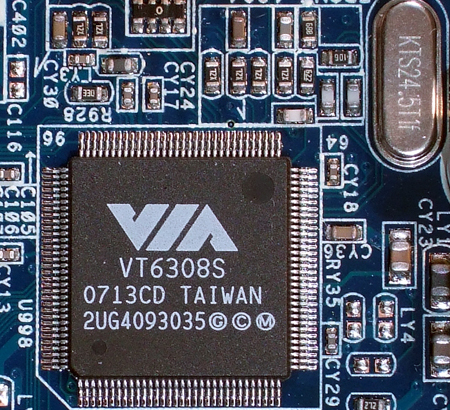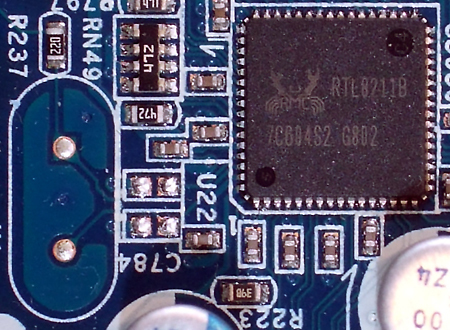NFORCE 780a SLI Motherboard Comparison
Onboard Devices
| Chipset | nForce 780a SLI |
| PCIe 2.0 Bridge | nForce 200 |
| Voltage Regulator | Six Phases |
| BIOS | 31b (04/18/2008) |
| 200 MHz HT Clock | 203.2MHz (+1.6%) |
| Clock Generator | ICS 9DB403DGLF |
| Connectors and Interfaces | Row 6 - Cell 1 |
| Onboard | 3x PCIe x16 (Modes: x16/x16/x1 or x16/x8/x8) |
| Row 8 - Cell 0 | 1x PCIe x1 |
| Row 9 - Cell 0 | 2x PCI |
| Row 10 - Cell 0 | 2x USB 2.0 (2 ports per connector) |
| Row 11 - Cell 0 | 1x WiFi USB Mini-Card Header |
| Row 12 - Cell 0 | 1x IEEE-1394 FireWire |
| Row 13 - Cell 0 | 1x Serial Port header |
| Row 14 - Cell 0 | 1x Floppy |
| Row 15 - Cell 0 | 1x Ultra ATA (2 drives) |
| Row 16 - Cell 0 | 1x Serial ATA to eSATA pass-through port |
| Row 17 - Cell 0 | 6x Serial ATA 3.0Gb/s |
| Row 18 - Cell 0 | 1x Front Panel Audio |
| Row 19 - Cell 0 | 1x CD-Audio In |
| Row 20 - Cell 0 | 1x S/P-DIF Out |
| Row 21 - Cell 0 | 1x Fan 4 pins (CPU) |
| Row 22 - Cell 0 | 1x Fan 3 pins (Chassis/Power) |
| IO panel | 2x PS2 (keyboard + mouse) |
| Row 24 - Cell 0 | 1x RJ-45 Network |
| Row 25 - Cell 0 | 6x USB 2.0 |
| Row 26 - Cell 0 | 1x External SATA |
| Row 27 - Cell 0 | 1x IEEE-1394 FireWire |
| Row 28 - Cell 0 | 2x Digital Audio Out (S/P-DIF optical + coaxial) |
| Row 29 - Cell 0 | 6x Analog Audio (7.1 Channel + Mic-In + Line-In) |
| Row 30 - Cell 0 | 1x WiFi Antenna Connector |
| Mass Storage Controllers | Row 31 - Cell 1 |
| nForce 780a SLI | 6x SATA 3.0Gb/s (RAID 0, 1, 5, 10 capable) |
| Row 33 - Cell 0 | 1x Ultra ATA 133 (2-drives) |
| Network | Row 34 - Cell 1 |
| Realtek RTL8111B PCI-E | Gigabit LAN Connection |
| Realtek RTL8187L USB | 802.11g/b Wireless Network Interface |
| Audio | Row 37 - Cell 1 |
| HD Audio Controller Interface | Realtek ALC890B 8-channel Codec |
| FireWire | Row 39 - Cell 1 |
| VIA VT6308S PCI | 2x IEEE-1394a (400 Mbit/s) |
Performance enthusiasts don’t always need the additional features that often accompany top-end boards, so ASRock shoots for value by reducing the number of onboard controllers. A single Gigabit Ethernet controller is supplemented by a WiFi adapter, but the K10N780SLIX3-WiFi has no auxiliary RAID controller or second Gigabit port.
The port panel thus fills basic needs, with the exception of a WiFi antenna connection that marks the board’s only excess. ASRock gets rid of legacy Parallel and Serial ports but keeps the PS/2 keyboard and mouse ports, and offers both optical and coaxial digital audio outputs.

Most noticeably lacking of the K10N780SLIX3-WiFi’s rear ports are any video outputs, which is requirement for the 780a SLI chipset’s “HybridPower” power-savings feature. The nForce 200 PCI-Express bridge still provides standard and 3-way SLI configurations without the potential energy savings, while lower-market buyers will appreciate the same “GeForce Boost” feature also found on lower-cost nForce 8000 series chipsets.

Audio comes from the Realtek ALC890B codec, with eight audio channels (7.1 surround) and 110db rated signal-to-noise ratio.

IEEE-1394 FireWire (aka, 1394a or FireWire 400) is slow enough to use a PCI interface without any additional performance limits, so ASRock connects one of the 780a SLI’s five PCI interfaces to connect a classic VIA VT6308S controller.

The 780a SLI has three spare PCI-Express x1 pathways, and ASRock routs these across two slots and one onboard controller. The Realtek RTL8211B Gigabit Ethernet controller uses the interface to provide bull bandwidth to both uploads and downloads simultaneously.

ASRock’s USB-based 802.11G wireless network adapter is identical to earlier Asus parts, right down to the model number on the lower rear corner. A Realtek RTL8187L does the work.
Get Tom's Hardware's best news and in-depth reviews, straight to your inbox.
-
a 6pack in so after reading all this.. i think im stickin with my 790FX. i was waiting for a quite a while for nvidia to pull something here with the 780a chipset. In my eyes its a fail.Reply
AMD's 790FX chipset provides significantly more lanes than nvidia. 3-way SLI is a novel idea but at x8 lanes for 3 slots.. not so much. while amd is providing full x16 support.
good info tho. if anything i would recommend the ASRock board also for nvidia's SLI path. -
johnbilicki I wan to see boards with two 16x slots and one 4x slot. Honestly I'm not interested in 100+ FPS at 1024x768 or 1280x1024 which is what you'll get in most games with triple SLI. The MSI board looks like they could have fit a couple more USB ports next to the useless firewire port. It's 2008 and I have yet to even see a product require a firewire port on products I'm only browsing on sales sites like Newegg or even just review sites. I liked Gigabyte's new quad gigabit port motherboard, finally 8 USB ports on the back! Also if no one shows up with a router at your LAN party three of your buddies can merely connect to your system any way (and who doesn't have dual LAN ports these days besides your cheap who cheaps out by five bucks on a north bridge).Reply
What is with the waste of brackets? Give us four USB ports on a bracket. If you upgrade even only once every four or five years you probably still have about five or six brackets laying around somewhere with all the firewire ports you could ever want...and if not your buddies do.
The dual-slot coolers on single slot cards, what a waste! If you're going to use a second slot don't waste the opportunity to move that hot air the heck out of the case!
My last criticism is the i-ram...DDR-1?! I love Gigabyte when it actually bothers to make boards using chipsets I'd want (they skipped the true 16X SLI and jumped on the then useless AM2 bandwagon however). So why aren't we seeing DDR2 RAM-drives? 4x4GB/32GB would be far out of most people's budgets but a 4x2GB/16GB RAM drive at $40/$160 dimm/total would *own* a raptor raid 0 any day in price/performance.
The manufacturers need to seriously start bringing some people in to the design rooms to question WTF they're thinking with their product designs because I see no reason to bother spending any money right now.
...and to clarify I enjoyed the article itself, it's just the products I hold disappointment in. The new chipset is great overall though. -
nukemaster DDR is still faster then any hard drive interface anyway(DDR 266 @ 2128MB/s), so why not? its actually limited by its sata 150 interface not the ram(it would also max sata 300).Reply
I agree DDR2 is the way to go, but only because the price is much lower and better capacities. When gigabyte designed the I-ram ddr was cheaper and ddr2 was new and expensive.
I think there is a DDR2 I-ram in the making -
I own an evga 780i and I am plagued with the video corruption problem like many other nvidia 7 series owners. BEWARE before you invest on these boards. Nvidia hasn't released a fix in 3 months. Many people can't watch video or play games without encountering a hard lock-up.Reply
Video of problem: http: //www. youtube. com/watch?v=TYHuzJSpORw
http: //www.evga. com/forums/tm.asp?m=253891&mpage=1&key=
http: //nvidia.custhelp. com/cgi-bin/nvidia.cfg/php/enduser/std_adp.php?p_faqid=2190
http: //vip.asus. com/forum/view.aspx?id=20080407161030625&board_id=1&model=Striker+II+Formula&page=1&SLanguage=en-us
http: //forums.anandtech.com/messageview.aspx?catid=31&threadid=2178960&FTVAR_STKEYWORDFRM=&STARTPAGE=1&FTVAR_FORUMVIEWTMP=Linear
http: //digg. com/hardware/780i_nvidia_motherboard_graphics_corruption -
jabliese No comparison of just the integrated graphics? One of the selling points for the 790 is it's DX10 support, would like to see some kind of comparison between just the integrated graphics, say, maybe on HDTV playback.Reply -
unifiedonboarddecoder They should also do the test using an ATi video card. I would like to see those benchmarks as well.Reply
